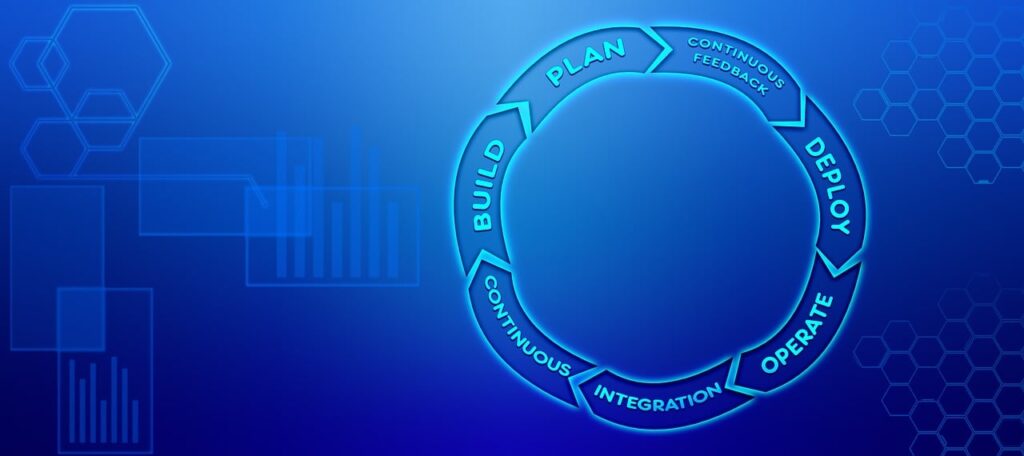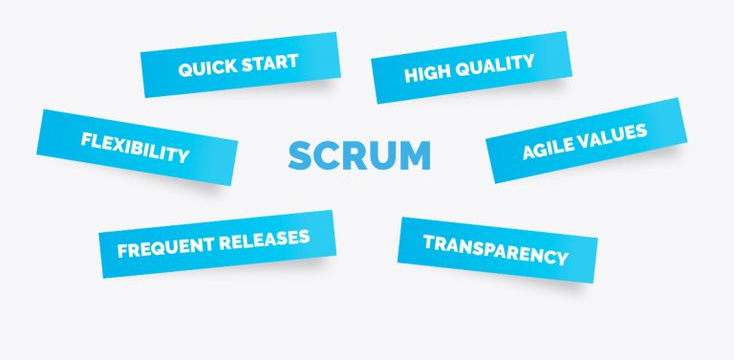You have probably already heard a lot about Scrum project management methodology being the most efficient software development methodology. However, many other frameworks nowadays provide teams with a dynamic systems development method.
It’s not always easy to distinguish between them and determine which would be the best fit for your product.
If you still feel confused when you hear the word “Scrum”, read this article where we explain what it is. For more information on how Scrum works, see this article.
Today, we’ll try to explain how Scrum relates to other project management methodologies and software development concepts.

What is Scrum methodology?
To start comparing Scrum’s project management philosophy to other methodologies, we must understand what Scrum is.
Scrum is part of the Agile methodologies, which means they share many principles. Scrum stands out because it encourages a team collaborative approach and self-organisation. This approach nurtures continuous improvement and adjustment to changing business needs.

Agile methodology vs Scrum
Agile is the umbrella project management philosophy that underpins several methodologies. Scrum is among the most popular Agile methodologies, along with Kanban and Extreme Programming.
Hence, it’s not quite right to set Scrum and other Agile methodologies against each other because Scrum is a specific Agile methodology.

The distinctive feature of all Agile methods is that they are lightweight, meaning they strive to reduce heavy planning and excessive regulation. That’s why agile software development is highly adaptable to changes and aimed at rapid delivery, constant improvements, and knowledge accumulation.
To make the difference between Agile and Scrum more clear, here’s how these two concepts correlate:
- Agile methodology is the generalized approach to software development, while Scrum is one of the ways it’s implemented.
- Agile does not have specific instructions on how the work should be done — it’s just a set of values and principles. Scrum includes rules and prescriptions that are based on these values and principles.
Summing up
One cannot choose between Agile methodology and Scrum because if you opt for Scrum software development, you actually choose a specific Agile methodology.
Kanban vs Scrum
Both Scrum and Kanban are Agile project management methods. And since they’re built on the same Agile principles, there are some similarities between these two approaches. For example, like in Scrum, the work in Kanban is done iteratively, and the development process is quite flexible.
However, the way a team collaborates and does the tasks is different.
In Japanese, the word “kanban” means “billboard” and the methodology got its name because it utilizes so-called kanban board. The board represents the items in a product backlog, and traditionally, it contains three key sections: tasks to be done, tasks in progress and completed tasks (see below).
Yet, there might be some variations to the Kanban board in software development. For example, a team may split the “in progress” column into “coding” and “testing” if needed.

Speaking about the Scrum vs Kanban, the differences are the following:
- Process. While the Scrum development process consists of fixed-duration sprints, the work in Kanban occurs as a continuous flow.
- Prioritization. In Scrum, the tasks are pulled from the product backlog in batches that form a sprint backlog. In the case of Kanban, a team delivers feature sets on an as-needed basis, and the new tasks are started only after the previous one is completed.
- Team roles. All members of a Scrum team have their own roles and responsibilities. In Kanban, the roles are not strictly defined, and the team members are encouraged to collaborate.
- Modifications. The changes in Kanban can be made at any time during the development process. Scrum framework allows for the modifications only after a sprint is completed, and any changes jeopardising the sprint goal are prohibited.
Summing up
Kanban and Scrum are efficient methodologies frequently applied in software development. However, Scrum has stricter rules regarding roles and delivery timelines, while it remains flexible and may be easily adapted to new conditions.
This allows a team to avoid chaos and keep the cadence. At the same time, since Scrum is more structured and predictable, clients receive their increments on predefined regularity and can better understand what’s happening on the project.
Waterfall vs Scrum
When it comes to software development, the confrontation between Waterfall methodology and Scrum (or even Agile vs Waterfall) is deemed to be the toughest one. This is because these two models represent diametrically opposite approaches to how a product is created.

Waterfall is a conventional project management methodology — it’s linear and sequential. This means that the whole process is broken into stages, which go one after another. A team has to finish one phase of the development before the next phase can begin.
The classic waterfall model of a software development process includes five stages: writing software requirements specifications, creating design, implementation (or coding), verification (or testing), and maintenance.
Waterfall and Scrum do not have much in common, so the list of differences can be really huge. But here are the most crucial of them for you to grasp the basic concept:
- Planning. Waterfall assumes that requirements are well-documented before the coding starts. This stage of the process usually takes a lot of time, so the delivery of the first feature set is postponed until everything is planned.
At the same time, Scrum does not have a lengthy pre-development stage — the team can start coding once the backlog for the first sprint is defined.
- Flexibility. In Waterfall, any changes to the development process are not favoured since you cannot go back to the prior stages.
On the other hand, the Scrum framework is extremely flexible — clients’ feedback is gathered on a regular basis and can be adapted to new conditions as needed after each sprint.
- Deliverables. If a development team applies the Waterfall methodology, clients see only the final product since software isn’t delivered until the whole work is done.
In Scrum, clients receive potentially releasable pieces of software after each sprint (i.e. every 2-4 weeks).
- Client involvement. Since clients in Waterfall are not actively involved in the process, software development is driven by contracts and documentation. In the case of Scrum, clients are invited to Sprint Review — an event aimed at inspecting and discussing work done within the sprint.
They have an opportunity to participate in the discussion and make comments on how to improve the product.
Summing up
Waterfall works well only for short-term, simple and fully predictable projects. It’s not the best option to use this methodology in software development since trying to predict everything in advance may be quite risky and ineffective.
On top of this, there is a good chance that clients will not be fully satisfied with the results because their desires and market conditions may change during the development process.
At the same time, Scrum allows teams and clients to eliminate these risks, making the process efficient and convenient for all sides.
XP vs Scrum
XP stands for Extreme Programming and, as mentioned above, is another agile development methodology. Since XP and Scrum have the same principles and values in their foundation, they have some common features.
Like Scrum, Extreme Programming aims to improve a product’s quality and adapt it to clients’ requirements. The work in XP is also based on early delivery, constant communication, client feedback, and an iterative process.
The word “extreme” in the name of this methodology is not accidental. XP strives to take best programming practices to an extreme level.
For example, if a team applies Extreme Programming methodology, they perform a code review constantly through pair programming (when two developers, a navigator and an observer, work together using one computer), unit and integration testing.
In the image below, you can see what the XP cycle looks like.

Yet, although Scrum and XP are both agile methodologies, they are different in terms of practical implementation:
- Focus. Scrum focuses on the big picture, i.e. the way the work is organized. At the same time, Extreme Programming deals with engineering things and prescribes how a team should build a product, i.e. the way the work should be done
- Product backlog. In Scrum, sprint backlog remains unchanged till the end of a sprint, while XP allows a team to swap items within one iteration.
- Roles and processes. XP does not contain any detailed instructions on team roles and processes. In Scrum, each team member has particular responsibilities and there are strict rules on how sprint events should be held.
Summing up
The main difference between Scrum and XP is that they focus on different things. Hence, it would be wrong to say that these methodologies are mutually exclusive.
The one may complement the other if a team decide to apply both of them simultaneously.
Yet, Scrum brings more benefits to clients since it makes the development process transparent, clear and organized. So we recommend opting for Scrum as the first priority and adding the XP framework to it if you want to have better control over the technical work.
Lean vs Scrum

Lean is a philosophy like Agile, not a methodology like Scrum. Its core principles include the following: eliminate waste, amplify learning, decide as late as possible, deliver as fast as possible, empower the team, build integrity and see the whole. Here’s how Lean, Agile and Scrum relate to each other:
- Lean vs Agile. While these philosophies have a lot in common, the difference between Agile and Lean is that they focus on different things (just like Scrum and Kanban). Agile is all about how separate projects are to be completed by a development team.
- At the same time, Lean takes a more systematic view and looks at how the entire organization is delivering its value.
- Scrum vs Lean. Scrum is based on Agile philosophy. However, since Agile and Lean are not contradictory in their nature, a Scrum master can also use Lean principles to deliver software.
Summing up
Scrum and Lean are concepts from different categories, so there can be no “either-or” choice. A team cannot do Lean, but it can certainly apply this philosophy to optimize software development, including processes within the Scrum framework.
Wrap-up
A project management methodology is one of the most essential factors influencing the quality of a product, as well as the level of clients’ satisfaction from the final results.
To pick the one that will suit your project best, we recommend you do deep research and think thoroughly about your expectations and needs.
Yet, as we see from the practice, Scrum provides clients with the optimal ratio of their involvement in the project, flexibility and well-organized processes.
FAQ
Agile methodology is a vast term that covers multiple project management methodologies. These methodologies follow the same Agile principles:
- Individuals and interactions over processes and tools;
- Working software over comprehensive documentation;
- Customer collaboration over contract negotiation;
- Responding to change over following a plan.
A Scrum master is a professional who leads the development team using Agile methodology during the development.
In Scrum methodology, sprint planning refers to determining the development approach: the duration, the goal, and where your development team starts. This process usually starts with setting the agenda and focus.
The implementation of Agile principles leads to a flexible and fast development cycle, as well as feature-driven development.






